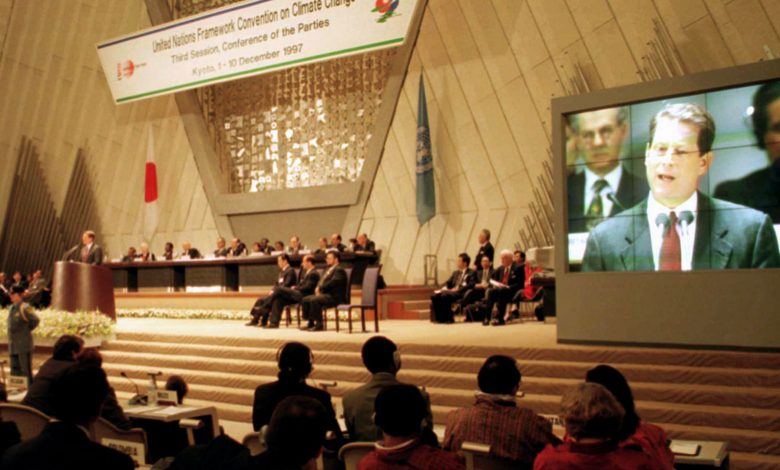How the Kyoto Protocol Failed to Reduce Fossil Fuel Emissions

Ratification of the Kyoto Protocol
The Kyoto Protocol was an international climate agreement that was formulated in 1997 to limit greenhouse gas emissions from industrialized nations. The agreement was ratified by 192 parties with the objective to establish a set of international emissions reduction targets that would limit global warming. The Kyoto Protocol is an historic agreement because it was the first legally binding international climate treaty aimed at limiting carbon dioxide emissions and other greenhouse gases from fossil fuel production (Schiermeier, 2012).
While developing countries were asked to voluntarily reduce their emissions, a group of 37 industrialized nations and the European Community were mandated to reduce their greenhouse gas emissions (UNFCCC, 2011). Between 2008 and 2012, the signatories of the Kyoto Protocol agreed to reduce their overall emissions to five percent below 1990 levels (UNFCCC, 2011). While the intention of the Kyoto Protocol was to initiate global efforts to reduce global warming, this agreement has had very little impact on the climate.

Immediate Criticism
After the Conference of the Parties to the United Nations Framework Convention on Climate Change (UNFCCC) met in Kyoto, Japan to develop the treaty, the agreement was almost immediately criticized for placing an economic burden on developed countries, while developing nations were given a great deal of flexibility and were exempted from the legally binding requirements of the agreement.
In total, there were over 100 developing countries that were excluded from the requirement to reduce emissions by five percent below 1990 levels. Developing nations were encouraged to set their own targets but, were not held to the same terms as developed nations. The United States initially signed the treaty but ultimately dropped out in 2001 when it became clear that developing countries like India and China were not going to initiate efforts to reduce the use of fossil fuels (Malakoff, 2007). Then in 2011, Canada officially rejected the agreement as well, citing the need to develop a new agreement to better address global emissions from all nations.

Emissions Reduction Flexibility
One of the mechanisms that made the Kyoto Protocol attractive, also made it ineffective. Besides the fact that developing nations were not required to establish emissions reduction plans, the Kyoto Protocol offered a great deal of flexibility to meet emissions reduction commitments. A number of innovative market-based mechanisms were employed that gave countries a few different options to meet targets.
Emissions Trading, the Clean Development Mechanism (CDM) and the Joint Implementation (JI) were three options that were offered to increase flexibility (UNFCCC, 2011). Therefore, in addition to meeting their commitments by reducing their own emissions, individual countries were given the option to buy emission allotments from other countries that had surpassed their established reduction targets, or could also get credits by making low-carbon technology investments in developing nations (Schiermeier, 2012).

Limited Effectiveness
Allowing countries to essentially bypass emissions reduction targets through carbon trading or other mechanisms may have made the Kyoto Protocol attractive from an economic standpoint, but it also reduced its effectiveness at cutting emissions from fossil fuels. What’s more troubling is that scientists have determined that even if all countries had achieved their five percent reduction targets, there would have been little to no effect on slowing the rate of global warming (Malakoff, 2007).
Even though the outcome of the Kyoto Protocol did not achieve a lasting impact against global warming, this treaty represents an important step forward in the fight to reduce greenhouse emissions. Some of the lessons learned from the Kyoto Protocol were worked into the establishment of the Paris Agreement, which effectively replaced the Kyoto Protocol in 2015. Overall, the Kyoto Protocol helped to raise global awareness about the impacts of increasing greenhouse gas emissions, while it also established the complicated groundwork needed for future climate-related policies.
Sources
Malakoff, D. (2007). “An Examination of the Kyoto Protocol” NPR.
Schiermeier, Q. (2012). “The Kyoto Protocol: Hot air” Nature.
UNFCCC. (2011). “Fact sheet: The Kyoto Protocol” United Nations Framework Convention on Climate Change.
Wong, A. (2018). “Even without the US, the Paris climate agreement can succeed where its predecessor failed” CNBC.



